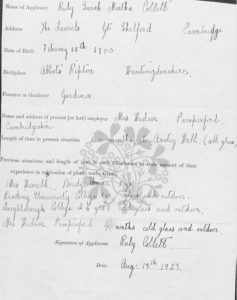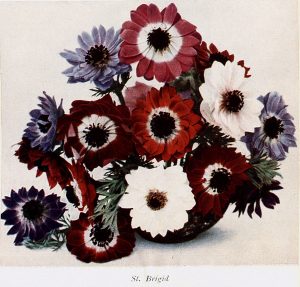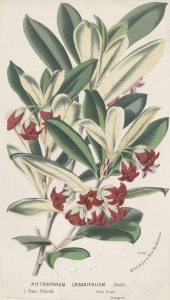‘I like to plant something every day!’
Ruby Collett was in her eighties when she made this remark to a younger neighbour. A student probationer gardener at RBGE in the 1920s, Ruby was a force of nature and I’d like to share some of her experiences with plants. During her time at RBGE she would learn much about propagating and tending new and established species. This practical learning period no doubt helped develop this very formidable plantswoman.

Ruby Collett Probationer Gardener Application Form
456 individuals were taken on as probationer gardeners at RBGE between 1889 and 1939. Only seven of that group (1.5 %) were women.
You can see a list of all of these probationers here.
The student probationer scheme was established in 1892 by Professor Isaac Bayley Balfour, Regius Keeper, to provide free courses of instruction in practical scientific horticulture and forestry over a period of 2½ years. Applicants had to be aged 25 or under with at least three years working experience in gardening or forestry. In return for full time work in the garden, pay was fixed at £1 1 shilling per week with extra pay for Sunday work. Courses of instruction were provided through evening classes taught by RBGE staff and external specialists, and on-the-job practical work.
Ruby was the seventh woman gardener to be accepted as a student probationer. In case you are wondering here is the list of the six women who preceded her at RBGE, with their years of training. Their stories all have interest, and may appear in future blogposts.
- Constance Ida Hay Currie (1873-1952). 1897. Eventually emigrated to British Columbia where she lived with her husband E. G. Beaumont on the remote Discovery Island.
- [Jane Torr] Lina Barker (1866-1929). 1897 to 1899. In 1900 established the first school of gardening for women in Scotland with her fellow probationer Annie Morrison as co-Principal.
- Annie Morison (1870-1948). 1898 to 1899.
- Amelia Jean Scott (1903-1925). 1919 to 1921. Lived within sight of RBGE and started as a probationer straight from school. Sadly died from peritonitis at a very young age.
- Mary Ord (1895- ) 1920 to 1923. Came to RBGE from Darlington where she had been in charge of the Alpine and Herbaceous Department at Kent & Brydon, a well-established firm of nursery and seedsmen. Returned to Darlington, where she married A. F. T. Ord.
- Edith Cairns (1898- ) 1922 to 1924. Married fellow probationer William P. Dodghson in 1926 in Alberta, Canada.
Ruby’s full name was Ruby Sarah Martha Collett. She was born on a large mixed farm at Abbot’s Ripton, Huntingdonshire in 1900. Prior to arriving at RBGE in August 1924 she garnered 5 years’ practical experience working in private and collegiate gardens.
From 1919 to early 1922 Ruby worked as a gardener at Reading University and Loughborough College. During this time she gained the R.H.S. Senior Certificate – 1st Class. At Loughborough she managed the garden and grounds of five student hostels and supervised a team of assistant lady gardeners.
J.F. Driver, Works Manager at Loughborough College gave Ruby a recommendation for her application to RBGE in which he states:
‘Besides being a good practical gardener Miss Collett has high theoretical qualifications, and has had excellent experience.’ J. F. Driver
In 1923 Ruby started as gardener in a private garden at Pampisford, Cambridgeshire, where she worked under glass and outdoors. Her employer was Mrs Annie Hudson, the widow of P R Hudson, a significant brewer in Cambridgeshire.
She took up her place at RBGE in the August of 1924 coming from a postion at Anstey Hall, Cambridgeshire, where she was working in the glasshouses. We know from a personal letter that she roared around Edinburgh on a motorcycle. Ruby excelled academically, never receiving a mark below 75 per cent and in two subjects (Systematic Botany and Meteorology) passing with full marks. When she left RBGE in February 1927, Sir William Wright Smith, Regius Keeper, noted in the certificate he issued that:
‘Her work in the Royal Botanic Garden has been performed carefully, skilfully and intelligently and her conduct has been in every respect satisfactory.’
On leaving RBGE Ruby was the first woman to gain a position with the Ministry of Agriculture as an Assistant Inspector of Horticulture. She worked primarily among the orchards in Worcestershire.
In 1933 she re-located to Cornwall, having amassed sufficient capital to purchase a farm of eight small fields covering approximately 12 acres and two cob-walled cottages, to become a producer of good quality flowers and fruit, a long held ambition of hers. The farm was located at Quenchwell, Perranwell, halfway between Truro and Falmouth. In March 1934 seed of forty-five shrubs and herbaceous plants, including Lilium regale, Ceanothus veitchianus, Spiraea douglasii and Meconopsis wallichii, were sent to Ruby from RBGE.
Ruby wrote about her experiences during the first six years’ of her flower farm in an article published in the August 1939 issue of The Journal of the Ministry of Agriculture.
Before Ruby purchased her farm she was advised to make sure the farm was saleable in the event of her failing to make good. Undaunted, she set to work, but with a plan that every endeavour had to be made to make both buildings and equipment serve more than one purpose. She also improved her farm by building a cottage for her foreman, improving her own cottage and building additional storage and picking sheds, a garage and water tanks.
As well as working on her farm herself, Ruby employed a small staff of three and took on horticultural students and employed seasonal workers for flower harvesting. One of the first things she tried to assess was whether mechanical or horse power was the best way of powering work on the farm. A rototiller won out over the horses, after some trying experiences. By 1939 the rototiller had more than paid for itself. Ruby continued using the rototiller for four years after which she purchased a tractor for ploughing, rolling and harrowing.

St Brigid anemone
By 1939 the crops cultivated included over an acre of anemones, the same of daffodils and 2 acres of strawberries, with smaller areas of violets, raspberries, blackberries and gooseberries. In the early years of the farm the number of strawberry plants sold was between 50,000 to 70,000 per year and the number of viola plants sold was between 20,000 and 50,000.
Here are a few of Ruby’s observations from her article:
‘I have worked up a connection for plants of high quality, which are despatched to all parts of Great Britain.’
‘I aim at the best; there is no stinting where manures and cultivators are concerned.’
‘I would like to emphasize the great importance of introducing the very best strains and stocks for the initial plantings.’
‘Any success I have achieved I attribute to the experience which comes from being born on a large mixed farm, to having had a horticultural training followed by a varied practical experience, to having enjoyed good health and to the possession of a large capacity for hard work.’
Sometime in the late 1940s Ruby re-located within Cornwall moving to Rosmergy, in the Parish of St. Agnes, in the Wheal Lawrence Valley, a former centre of Cornish copper-mining. Here she established another flower farm from five fields. Ruby’s enthusiasm for plants meant that she was a very hard worker who expected more of her employees than was perhaps the norm. Someone who worked for her for a short period recalled her as a ‘hard taskmaster.’ One thing that Ruby grew commercially at Rosmergy was shrubs including Pittosporum. Amongst the seeds sent from RBGE in 1934 were seeds of P. crassifolium and P. divaricatum. P. crassifolium, a native of New Zealand, was particularly suited to the climate of the south-west and has naturalised in some places in Cornwall.

Pittosporum crassifolium
In a letter, Mrs Isobel Burrows, whose mother was a friend of Ruby’s, describes the beauty of the garden Ruby created around her cottage situated only half a mile from the sea. Ruby planted a protective shelter belt of pines, olearia, griselinia and elaeagnus, within which she grew single specimen trees such as Cornus kousa, eucalyptus and copper beech. In front of the cottage were a tree paeony and a flowering cherry. Fuchsia magellanica provided an edging on one side of the drive up to the cottage. The garden was particularly attractive in winter when camellias and Rhododendron ‘Christmas Cheer’ flowered. Gunnera planted by Ruby is remarked on by walkers in the area to this day.
A keen golfer, Ruby played the game well into her eighties. She created a practice green on part of her land, and tended it with a particular pride, offering sixpence to any child who could discover a dandelion growing on it.
Ruby reached the age of 90 but sadly died in her garden, in tragic circumstances, on Boxing Day 1990.
Anne Meredith looks in more detail at Miss Collett’s experiences in her thesis ‘Middle class women and horticultural education, 1890-1939’ Ph.D. University of Sussex (2001). [EThOS ID: uk.bl.ethos.390831]
My thanks are due to Mr Tom Thompson (St Agnes Museum (www.stagnesmuseum.org.uk)), Mrs Isobel Burrows, and Mr & Mrs John Branfield for providing information about Miss Collett and her garden and nursery at Rosmergy.
Written by Graham Hardy, May 2016

Patricia Keegan
I was very interested to read this article. Having know Ruby Colletts sister personally. I was doing some research when l came across this. Thank you so much for posting.
Patricia Keegan
Patricia Keegan
patricia keegan
i am currently working on my book The Lady and the Legacy about Ruby’s sister the eponymous Enid Collett. She left almost £ 3 million to RNLI which funded the State of the Art Tamour Lifeboat based at Shoreham on Sea Sussex. it contains events of when Ruby was a child. if you have any information on Ruby, I am most interested to hear it and maybe include it in my book. Thank you for printing this wonderful article.